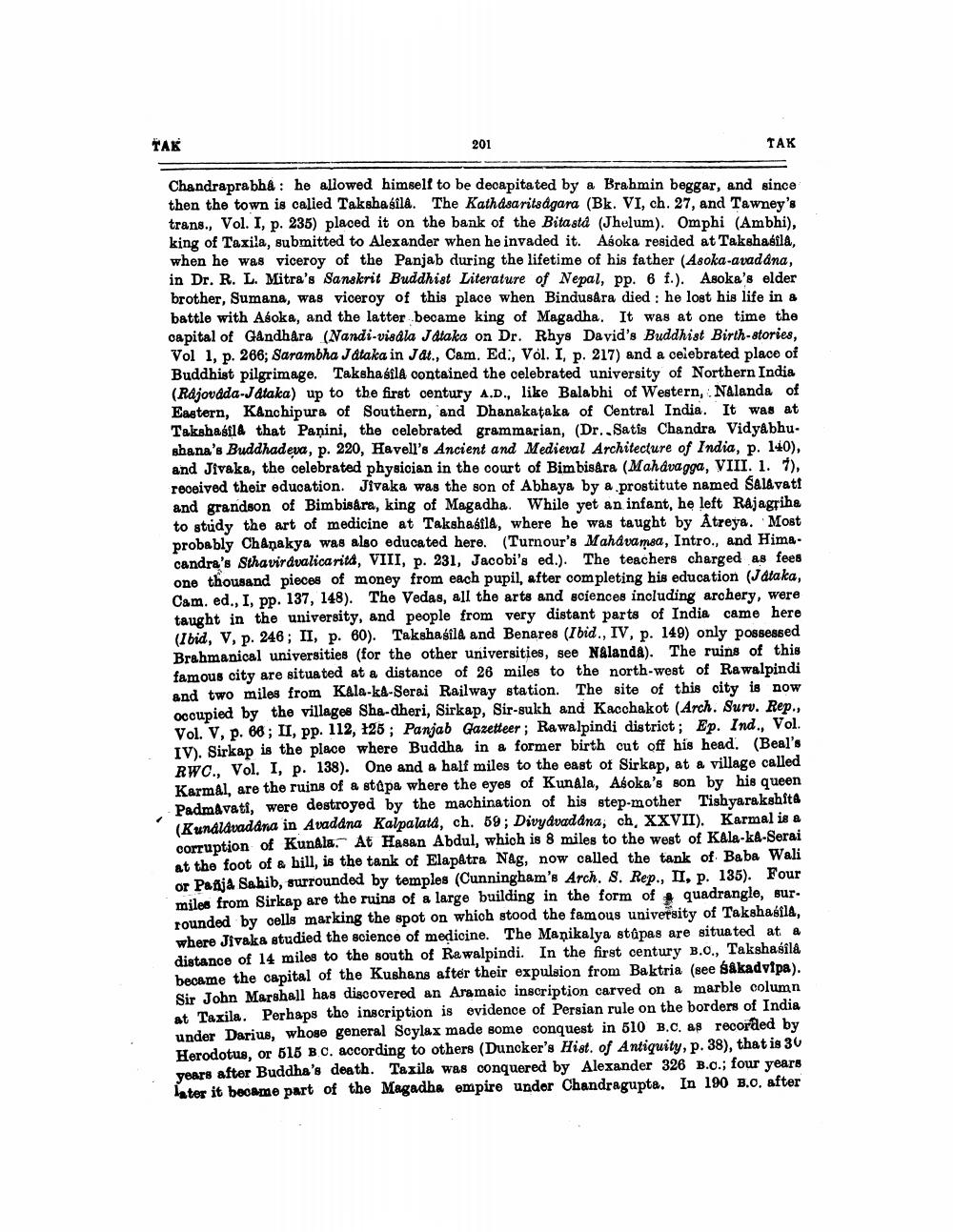________________
TAK
201
TAK
---
Chandraprabh: he allowed himself to be decapitated by a Brahmin beggar, and since then the town is called Taksbasila. The Kathasaritsagara (Bk. VI, ch. 27, and Tawney's trans., Vol. I, p. 235) placed it on the bank of the Bitasta (Jhulum). Omphi (Ambhi), king of Taxila, submitted to Alexander when he invaded it. Asoka resided at Takshasila, when he was viceroy of the Panjab during the lifetime of his father (Asoka-avadana, in Dr. R. L. Mitra's Sanskrit Buddhist Literature of Nepal, pp. 6 f.). Asoka's elder brother, Sumana, was viceroy of this place when Bindusara died: he lost his life in & battle with Asoka, and the latter became king of Magadha. It was at one time the capital of Gandhara (Nandi-visala J Ataka on Dr. Rhys David's Buddhist Birth-stories, Vol 1, p. 266; Sarambha Jataka in Jat., Cam. Ed., Vol. I, p. 217) and a celebrated place of Buddhist pilgrimage. Takshasila contained the celebrated university of Northern India (Rajovada Jataka) up to the first century A.D., like Balabhi of Western, Nalanda of Eastern, Kanchipura of Southern, and Dhanakataka of Central India. It was at Takshasil A that Panini, the celebrated grammarian, (Dr. Satis Chandra Vidyabhu. shana's Buddhadeva, p. 220, Havell's Ancient and Medieval Architecture of India, p. 140), and Jivaka, the celebrated physician in the court of Bimbisara (Mahavagga, VIII. 1. 7), received their education. Jivaka was the son of Abhaya by a prostitute named Salavati and grandson of Bimbisara, king of Magadha. While yet an infant, he left Rajagrihe to study the art of medicine at Takshasila, where he was taught by Atreya. Most probably Chanakya was also educated here. (Turnour's Mahavamsa, Intro., and Himacandra's Sthavir dvalicarita, VIII, p. 231, Jacobi's ed.). The teachers charged as fees one thousand pieces of money from each pupil, after completing his education (Jataka, Cam. ed., I, pp. 137, 148). The Vedas, all the arts and sciences including archery, were taught in the university, and people from very distant parts of India came here (Ibid, v, p. 246 ; II, p. 60). TakshasilA and Benares (Ibid., IV, p. 149) only possessed Brahmanical universities (for the other universities, see Nalanda). The ruins of this famous city are situated at a distance of 26 miles to the north-west of Rawalpindi and two miles from Kala-ka-Serai Railway station. The site of this city is now occupied by the villages Sha-dheri, Sirkap, Sir-sukh and Kacchakot (Arch. Surv. Rep., Vol. V, p. 66; II, pp. 112, 125; Panjab Gazetteer ; Rawalpindi district: Ep. Ind., Vol. IV). Sirkap is the place where Buddha in a former birth cut off his head. (Beal's RWC., Vol. I, p. 138). One and a half miles to the east of Sirkap, at a village called Karmal, are the ruins of a stopa where the eyes of Kunala, Asoka's son by his queen Padmavati, were destroyed by the machination of his step-mother Tishyarakshita (Kunalavadana in Avadana Kalpalata, ch. 59; Divy dvadana, ch, XXVII). Karmal is a corruption of Kunala. At Hasan Abdul, which is 8 miles to the west of Kala-ke-Serai at the foot of & bill, is the tank of Elapatra Nag, now called the tank of Baba Wali or Pakja Sahib, surrounded by temples (Cunningham's Arch. 8. Rep., II, p. 135). Four miles from Sirkap are the ruins of a large building in the form of quadrangle, sur. rounded by cells marking the spot on which stood the famous university of Takshasila, where Jivaka studied the science of medicine. The Manikalya stúpas are situated at a distance of 14 miles to the south of Rawalpindi. In the first century B.o., Takshasila became the capital of the Kushans after their expulsion from Baktria (see Sakadvipa). Sir John Marshall has discovered an Aramaic inscription carved on a marble column at Taxila. Perhaps tho inscription is evidence of Persian rule on the borders of India under Darius, whose general Soylax made some conquest in 510 B.C. as recorded by Herodotus, or 515 B C. according to others (Duncker's Hist. of Antiquity, p. 38), that is 30 years after Buddha's death. Taxila was conquered by Alexander 326 B.C.; four years hater it became part of the Magadhe empire undor Chandragupta. In 190 B.O, after




